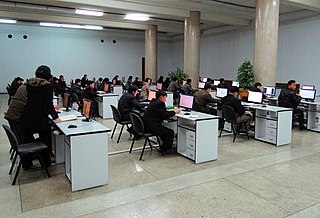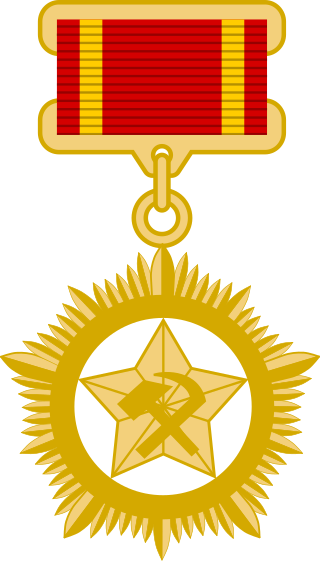
The Internet Corporation for Assigned Names and Numbers is a global multistakeholder group and nonprofit organization headquartered in the United States responsible for coordinating the maintenance and procedures of several databases related to the namespaces and numerical spaces of the Internet, ensuring the Internet's stable and secure operation. ICANN performs the actual technical maintenance work of the Central Internet Address pools and DNS root zone registries pursuant to the Internet Assigned Numbers Authority (IANA) function contract. The contract regarding the IANA stewardship functions between ICANN and the National Telecommunications and Information Administration (NTIA) of the United States Department of Commerce ended on October 1, 2016, formally transitioning the functions to the global multistakeholder community.
Telecommunications in North Korea refers to the communication services available in North Korea. North Korea has not fully adopted mainstream Internet technology due to some restrictions on foreign interventions.
The domain com is a top-level domain (TLD) in the Domain Name System (DNS) of the Internet. Created in the first group of Internet domains at the beginning of 1985, its name is derived from the word commercial, indicating its original intended purpose for subdomains registered by commercial organizations. Later, the domain opened for general purposes.

The domain name .org is a generic top-level domain (gTLD) of the Domain Name System (DNS) used on the Internet. The name is truncated from 'organization'. It was one of the original domains established in 1985, and has been operated by the Public Interest Registry since 2003. The domain was originally "intended as the miscellaneous TLD for organizations that didn't fit anywhere else." It is commonly used by non-profit organizations, open-source projects, and communities, but is an open domain that can be used by anyone. The number of registered domains in .org has increased from fewer than one million in the 1990s, to ten million in 2012, and held steady between ten and eleven million since then.

Verisign, Inc. is an American company based in Reston, Virginia, that operates a diverse array of network infrastructure, including two of the Internet's thirteen root nameservers, the authoritative registry for the .com, .net, and .name generic and the .cc country-code top-level domains, and the back-end systems for the and .edu sponsored top-level domains.

The Korean Central News Agency (KCNA) (Korean: 조선중앙통신) is the state news agency of North Korea. The agency portrays the views of the North Korean government for both domestic and foreign consumption. It was established on December 5, 1946, and now features online coverage.

.bz is the Internet country code top-level domain (ccTLD) for Belize. It is administered by the University of Belize.

.sg is the Internet country code top-level domain (ccTLD) for Singapore. It was first registered in September 1988. It is administered by the Singapore Network Information Centre. Registrations are processed via accredited registrars.

.ky is the Internet country code top-level domain (ccTLD) for the Cayman Islands. The code was chosen as other possible options had already been allocated. Registration was limited to residents and registered companies in the Cayman Islands with a local address, but this restriction was removed in September 2015. The Cayman Islands also has the international three-letter code CYM and has won a bid to be awarded the .cym domain in a future expansion of the top-level domain space.
Naenara is the official web portal of the North Korean government. It was the first website in North Korea, and was created in 1996. The portal's categories include politics, tourism, music, foreign trade, arts, press, information technology, history, and "Korea is One".

The Korea Computer Center (KCC) is the North Korean government information technology research center. It was founded on 24 October 1990. KCC, which administered the .kp country code top-level domain until 2011, employs more than 1,000 people.

The DPR Korea Premier Football League is the men's top professional football division of the North Korean football league system. The DPR Korea Premier Football League was established in 2017, replacing previous football tournaments held in a knockout format which served as a highest-level football competition in the Democratic People's Republic of Korea.

Internet access is available in North Korea, but is only permitted with special authorization. It is primarily used for government purposes, and by foreigners. The country has some broadband infrastructure, including fiber optic links between major institutions. Online services for most individuals and institutions are provided through a free domestic-only network known as Kwangmyong, with access to the global Internet limited to a much smaller group.

Kwangmyong is a North Korean "walled garden" national intranet service opened in the early 2000s. The Kwangmyong intranet system stands in contrast to the global Internet in North Korea, which is available to fewer people in the country.

Red Star OS is a North Korean Linux distribution, with development first starting in 1998 at the Korea Computer Center (KCC). Prior to its release, computers in North Korea typically used Red Hat Linux, and later switched to modified versions of Microsoft Windows with North Korean language packs installed.

Koryolink is a North Korean wireless telecommunications provider. The company is a cellular operator held by Cheo Technology, a joint venture between Orascom Telecom Media and Technology Holding (OTMT) which holds 75% of the shares, and the state-owned Korea Post and Telecommunications Corporation (KPTC). Koryolink started in 2008 and was the first 3G mobile operator in North Korea.

Television in North Korea is subject to the Korean Central Broadcasting Committee and controlled by the Propaganda and Agitation Department of the Workers' Party of Korea. A study in 2017 found that 98% of households had a television set. As of 2020, there are over-the-air broadcasts in both analogue and recently launched digital formats.

Korean Central Television is a North Korean television service operated by the Korean Central Broadcasting Committee, a state-owned broadcaster in North Korea. It is broadcast terrestrially via the Pyongyang TV Tower in Moranbong-guyok, Pyongyang, streamed via the government-run internet television service Manbang, and also uplinked via satellite.

Labor Hero is one of the highest titles of honor of North Korea and the highest decoration of the country overall. The award was probably scheduled for establishment in the summer of 1950, but the Korean War postponed these plans. When the war had entered a phase of stalemate along the 38th parallel, the government had time to officially launch the decoration, originally under the name Korea Hero of Labor. 16 people were decorated Labor Heroes during the war and more since then. The decoration is based on its Soviet equivalent, Hero of Socialist Labour.
















